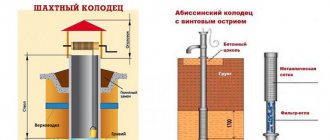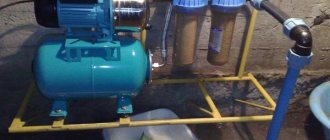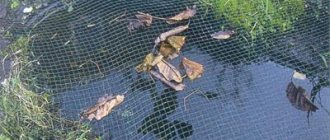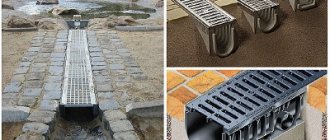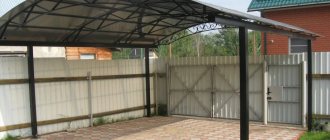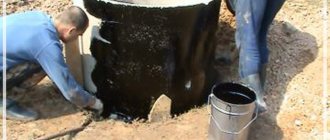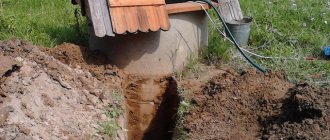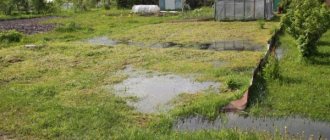It is very often impossible to connect a small country estate to a central water supply due to the remoteness of the water supply main. Digging a well or drilling a well is sometimes unaffordable, and to build an autonomous system you need your own source of water.
In such cases, you can equip an Abyssinian well with your own hands - the technology for organizing such a source of water intake is quite simple. Agree, before starting to implement the idea, it is necessary to understand the design and operating principle of the system.
We will tell you how to plan an Abyssinian well, what equipment you will need and how to make an igloo well yourself. Particular attention should be paid to the type of soil on the site.
Operating principles of the Abyssinian well
An Abyssinian well is a simplified version of a well that allows you to obtain water from the first or second aquifer lying on top. Its design is extremely simple. It is a column of interconnected gas-supply steel pipes with a primitive filter and a metal tip at the bottom.
The thin trunk of the excavation looks like an ancient sewing device. Hence the second name: needle well.
A well-designed Abyssinian well will provide water supply to a personal plot no worse than a mine well and will not be inferior to it in durability
The classic method of immersing an Abyssinian well into the ground is done by banal driving - the simplest method, actively used among independent craftsmen. They hammer until the lower pipe with the tip opens the aquifer.
Sometimes the column is partially buried by auger drilling, but renting a manual or mechanical drilling rig significantly increases the work budget.
The Abyssinian well was invented and tested during the war between colonial England and Ethiopia in 1867-68. The design proposed by the American engineer Norton tirelessly provided the British troops with water during their movements across the desert.
Image gallery
Photo from
The installation of a needle well will take a minimum of money
Water is pumped out using surface pumps
The flow rate of the Abyssinian well does not differ from the standard one
Drilling an Abyssinian well in the basement
The device for extracting life-giving liquid from underground layers of soil was quickly installed, dismantled and used again at the next stop.
Such priorities as mobility, low cost and simplicity of construction were appreciated by the military and attracted travelers and researchers.
The advantages of constructing a needle well with your own hands are simplicity and minimal construction time, easy dismantling and budget cost (+)
In Russia, they became acquainted with a wonderful invention a year after the end of the English campaign. A device for lifting water from a shallow depth was described by K.I. Maslyannikov in a book dedicated to the effective drilling equipment that was in use at that time.
Of the five Abyssinian wells built in the Tsarskoe Selo area, two turned out to be quite suitable for obtaining fresh water. Three were unable to reach the aquifer due to limestone lying close to the surface.
Successful Abyssinian wells yielded a bucket per minute. At first there was a cloudy slurry, which after pumping for half an hour became quite transparent and clean.
A needle well penetrates only the first aquifers from the earth's surface, so the resulting water cannot be used for drinking purposes. It is suitable for watering, cleaning the area and similar household needs.
If desired, and the production flow rate is impressive, a system of coarse and fine filters can be installed to purify water, trapping mechanical inclusions and chemical impurities.
A significant drawback of the Abyssinian well is the insignificant depth of water intake associated with the use of surface pumps, however, this is the most convenient source of temporary use
Features of operation
The width of the recess is 2.5-5 m, and the depth is no more than 10-15 m. A manual or electric pump is used to pump out water. Its power should be enough to lift resources from a distance of 15 m. When water is withdrawn, a vacuum is created inside the recess, and fresh water comes in to replace the pumped out water.
If the filter becomes clogged, the pipe will need to be flushed with water. If this does not solve the problem, the needle needs to be replaced.
With regular and proper use, the well will last a long time. If it is used seasonally during the warm period, then it will have to be preserved for the winter.
To do this, just empty the well and cover the pump with waterproof material. With the onset of the spring season, pumping should be carried out.
Structural specifics of the needle well
The Abyssinian drilling rig, developed a century and a half ago, has not undergone any fundamental design changes over the past years. For some time it was completely undeservedly forgotten. Although in terms of the speed and simplicity of construction, it is noticeably ahead of widespread traditional wells, as well as the price of construction.
There are two main components in the design of an Abyssinian well:
- Drilling tool , which includes a tip that cuts the soil and a barrel that is extended during the process of penetration into the ground. The trunk also serves as a channel for lifting water from the depths. Therefore, it is assembled from pipe sections, and not from a steel circle or rod.
- Koper , consisting of a metal tripod and a heavy woman playing the role of a hammer. At the top of the tripod there are two blocks with ropes stretched through them, to which the woman is tied.
When the ropes are pulled, the woman rises to the top of the installation. When weakened, it rapidly falls onto the headstock, which is rigidly fixed on the section of the trunk being driven in. The latter performs the function of an anvil, thanks to which the trunk is consistently immersed in the ground.
The main part of the Abyssinian well is a pipe tip with an internal diameter of 11/4 11/2 and 2 inches and consists of a correspondingly perforated gas tube like a filter and equipped with a spear-shaped thickening at the end (+)
The headstock is a kind of clamp, consisting of two symmetrical parts. The area of the headstock surface in contact with the headstock is slightly larger than the area of the bottom of the “hammer” falling on it.
After the section of the trunk being driven is almost completely immersed in the ground, the headstock is removed. The next section of the pipe is screwed to the buried section, on which the anvil clamp is once again fixed.
Falling, the woman hits the lower clamp and deepens the pipe; as the well deepens, the headstock and clamp with blocks are moved up the pipe
The steps to deepen the drill bit are repeated until the lower part of the do-it-yourself needle well reaches the aquifer. The water carrier must not only be opened, but also passed at least a meter.
According to the rules, the layer should be crossed at 2/3 of its thickness, but the actual dimensions of the water carrier are probably unknown to an independent driller. It is difficult to judge them without hydrogeological surveys.
To obtain water, a tripod is installed in a specific place, the tip is screwed onto a gas pipe, on which a woman is put, and the pipe is driven into the ground with the woman (+)
The appearance of water in the workings must be periodically monitored. For the purpose of measuring the water level in the workings, professional drillers have a simple device that ideally determines the depth of the aquifer when it lies up to 15 m.
This is a hollow metal cylinder called a clapper. The device looks like an inverted thin glass attached through a loop to a tape measure.
The working body of a firecracker is a hollow cylinder or cone, which, when in contact with the surface of the water, produces a characteristic clap: you can make a similar device with your own hands
When the edge of the firecracker comes into contact with the surface of the water, a pop is heard, indicating the appearance of the desired object in the well. You can make such a control device yourself by tying a large nut to a string so that it can come into flat contact with the surface of the water.
Instead of a nut, it would be nice to find a not too lightweight plastic or metal cone, open on one or both sides.
There is another ingenious tool that serves as a control device. It is trivial to monitor the appearance of water in an Abyssinian well by lowering an ordinary polymer pipe into the shaft. A characteristic clap will signal contact with the groundwater table.
Video description
Here's how to set up a well in two hours:
You can install blocks above the pipe to lift the headstock using ropes. This way you can increase the impact force.
Once the pipe is completely installed, it is necessary to pump the water to get rid of the sand and get to clean water. In the future, it is recommended to use a pump to pump water.
It is recommended to place the pump in a lift. To do this, a concrete pad is made from below, and concrete rings are installed as walls. The top is made closed, and the water supply pipe is led out through the lid. With such a device, the likelihood of contamination of the resulting water will be minimal.
Improvement of the filtration element
The described filter will protect against the ingress of gravel and small pebbles, but will not get rid of smaller inclusions. Therefore it needs modernization. To turn a perforated piece of pipe into a filter with a higher degree of protection, it needs to be modified.
Procedure:
- Turns of stainless wire are wound over the pipe. They are needed to increase the area of the filtering organ. The distance between the turns is 3 – 5 mm.
- The resulting workpiece is tightly wrapped in a piece of stainless mesh, which is soldered to the walls of the pipe. They use exclusively tin solder, because the use of an alloy with lead will negatively affect the quality characteristics of the water.
There is an opinion that to make it even more important, the upgraded filter should be wrapped on the outside with stainless steel wire rod. Let us allow ourselves to doubt the reliability of such a fortification. We believe that when immersed in the ground, the outer coils of a homemade filter will certainly come loose, increase friction and make plugging noticeably more difficult.
Well filters use P52 galloon mesh, which allows you to filter out fine and silty sands, thereby protecting the well from silting
Refining the filter is a good thing, helping not only to optimize water quality, but also preventing silting of the needle well.
True, with all the prostate of the device, strict adherence to the rules is required:
- A mesh made of brass or other non-ferrous metals is not suitable for a mesh filter. In union with steel, with strong soldering, they will form a galvanic couple, quickly and easily corroded by corrosion.
- The diameter of the perforated pipe together with the additional filter should not be equal to or exceed the maximum diameter of the tip. Otherwise, important filter additives will separate from the pipe when driven into the ground.
- For the construction of the drill string and the first link, which is the water intake part of the shaft, fragile cast iron pipes are not suitable.
You should not save on couplings by buying handicrafts with low-quality cutting. If the connections come apart during driving, the needle will have to be dismantled and the hole must be drilled again.
Filter importance
The quality and quantity of produced water depends on the filter. The wellpoint filter must be porous (borehole). The 1 m long support frame is a pipe with frequent holes. It is wrapped in a wire spiral, then covered with 2 layers of filtration mesh and wrapped in geotextile. This way the filter will last 2-3 times longer.
The frame, filter mesh, and spiral must be made of stainless steel, the cone must be made of any steel. You can use plastic pipes (PVC, PVD). Such filters become overgrown more slowly, are easier to clean, and can withstand washing with acids or chemicals to dissolve cemented plaque.
Note: for medium-grained sands, smooth meshes (gallon) are used; for mixed-grained and coarse-grained sands, meshes with square cells are used.
Conditions for the construction of an Abyssinian well
To install an Abyssinian well, the ardent desire of the owner of the site, supported by knowledge of the design of the water intake installation, is not enough. Before starting work, it is necessary to find out whether the geological conditions are suitable for constructing a needle well.
The soils lying in the ground differ in physical and mechanical properties: density, structure, hardness parameters, etc. Drillers have a classification based on the so-called “drillability” of rocks.
For excavation of sandstone and sand, for example, different types of tools and drilling methods are used. Rocky sandstone is drilled with a core pipe with a carbide crown, and water-bearing sands are lifted using the shock-rope method using a bailer.
The installation of an Abyssinian well cannot be carried out if limestone (1), sandstone (2) is located close to the surface; the optimal soils for work are clay deposits (3) and sands (4)
Based on the totality of physical and mechanical properties, together with drillability, rocks are conventionally divided into:
- Hard or rocky . They are capable of splitting, crushing, and are gradually destroyed when drilling at high speed and pressure. Hard rocks are represented in the upper part of the sediments by limestones, sandstones, marls, dolomites, etc.
- Plastic . They can be easily or relatively easily cut with a knife and a drilling tool, including the tip of an Abyssinian borehole. Plastic representatives include clays, loams, and sandy loams with a high plasticity number.
- Bulk . They don't keep their shape because... consist of particles that are not connected to each other. When saturated with water, some silty species can “float.” The loose variety includes sand of all sizes, gravel-pebble, gruss-crushed stone and similar deposits.
At the disposal of home craftsmen who want to construct an Abyssinian well, there is no drilling tool for drilling all of the listed types of soil. Independent drillers will be able to cross only plastic and granular categories. It is impossible to crush hard rock with the tip of an Abyssinian well.
Sedimentary deposits are ideal for the construction and normal operation of an Abyssinian well: gravel, crushed stone, pebbles with filler, sand, sandy loam, loam (+)
You should not try to break a large boulder: it is better to move a little and start working there again. Moreover, dismantling the water intake device is many times faster than installation.
In addition to restrictions on drillability, the possibility of constructing a needle well is affected by the height of the water surface. The fact is that extracting it from a thin-walled excavation can only be entrusted to surface pumping equipment. Most brands of surface pumps are ready to lift water from a depth of no more than 8 m.
To pump water from a needle well, surface pumping equipment is used, extracting water from an average depth of 8 - 10 m
Even if the technical data sheet indicates a suction depth of about 10 m, we must not forget about the standard pressure losses in the barrel and the fact that the pump usually also transports water along a horizontal section.
Every 10 m of horizontal movement takes away 1 m from the suction depth. In addition, surface pumps are strongly recommended to be located in enclosed spaces, and they are often remote from the water intake point.
If, apart from the Abyssinian well, there is absolutely no way out, and the depth of water in nearby wells is fixed at 12 - 15 m from the surface of the earth, then to raise the water you should stock up on an airlift or a hand pump capable of pumping water from the indicated depth.
To pump water from a depth of more than 15 - 20 m, you can use an airlift, which, in addition to transporting water, saturates it with oxygen
Useful information on how to find water for a well on a site and assess the location of aquifers is presented in this article.
An alternative option for adapting the water intake needle to an unsuitable groundwater level is to construct a pit. Before driving the column into the ground, a hole is dug about a meter deep, the width of which is convenient for working with a shovel in it. Driving the rods then begins from the bottom of the hole. In such situations, the pump is installed in a pit.
If the groundwater in the area lies lower than the maximum suction depth of the pump, construct a pit and place pumping equipment in it
Main advantages
The list of advantages of the Abyssinian system is quite extensive.
It includes the following items:
- Extended service life. The service life of the recess is 50-70 years, and if you provide it with proper care, it will be increased to 100 years.
- Wear resistance. The design is not afraid of the negative impact of various factors, including precipitation, soil movements, etc.
- No installation difficulties. You can equip the structure with your own hands without the involvement of equipment or specialists. If you do not want to carry out drilling activities, you can use the turnkey construction service. Specialists will be able to solve the problem in 1 business day.
- Easy to dismantle. If there is a need to remove the system from the structure for the purpose of maintenance or moving to another location, then such a process will not take much time and effort.
- Safety. The liquid that rises to the surface contains no harmful impurities. In addition, the tip does not cause damage to the soil.
- Low cost. The construction of the Abyssinian system is not accompanied by large expenses. So, to build a classic version you will need to pay 4 times more.
- Compact sizes. The design does not take up much space.
- Versatility. An autonomous source of water supply can be installed both on the street and in the house. To do this, you need to connect the pumping equipment through a check valve and hide it behind the door structure.
- Continuity. The structure can supply water without interruption, provided that the aquifer is large enough.
- No difficulties in care. The design does not require frequent and thorough maintenance.
The well does not take up much space.
Your own hydrogeologist: soil assessment
No matter how simple the process of driving a needle is, careful preparation for the work is still necessary. It is not enough to stock up on rods and a starting unit with a filter, rent or make your own pile driver. We need information about the geological and hydrogeological situation in the area where the Abyssinian well was constructed.
Where and how to get them? We can literally get information about the groundwater level from a neighbor’s well or borehole.
We will measure it ourselves with a clapper or ask the owner of the source about the depth from which he pumps water. At the same time, we will find out what kind of soil was lifted from the face when they drilled or dug a working.
The driver and the barrel for the needle well are not produced by industry; the installation with all the accessories can be purchased ready-made or ordered to be manufactured
In flat areas, rock layers lie almost horizontally with a slight bend or slight slope. The groundwater table is approximately at the same absolute level. The difference in the depth of the existing and planned well can only be expressed due to differences in relief.
Do not forget that the Abyssinian well reveals the perched water or the following aquifer, covered by clay or loam, but not rock aquifer. Those. The water level in the mine will definitely be unstable - depending on the volume of precipitation.
During the period of snowmelt and rainy season, the groundwater table will be higher than in the dry weather season. You should find out from the owner of the existing water intake point what the maximum and minimum differences in water level are, so that during a dry summer the Abyssinian well does not turn out to be empty.
If the walls of the excavation are composed of stable, non-crumbling soils, the well can be partially drilled using a manual drilling rig with an auger
The question about the breeds being developed is not at all idle. For example, in the Leningrad region, water is extracted from large sands with a significant number of massive boulders.
Often, due to the inability to crush and remove a huge stone, drillers displace the water well. It is worth doing the same if there are similar soils in the region where the Abyssinian well was constructed.
It makes no sense to carry out driving in high-lying rock and semi-rock massifs. If the neighboring area receives underground water, common in fractured dolomites, sandstones, limestones, then the idea of constructing a needle well will have to be mercilessly abandoned.
Detailed information on conducting geological surveys is presented in the article - Where and when is it better to drill a well on a site: general rules + advice from experienced drillers
For those who decide to make an Abyssinian well with a pit, information is needed about the structure and condition of the soil layers lying at the depth of the pit. If the section is composed of sandy loam, loam, or their alternating layers, it is not necessary to strengthen the walls of the pit.
Loose, unstable walls of the pit should be strengthened so that the wellhead of the needle well and pumping equipment are not covered with loose soils
If the pit is dripping in sand, the walls should be reinforced with boards or concrete. Sandy sides are unstable and can collapse and cover the water intake point along with the pumping equipment.
Questions about the upper layers of soil are also necessary for those who plan to go through the upper part of the excavation with an auger. Auger drilling will significantly speed up the process, but may not bring the planned result. For work, use a simple device - a purchased or homemade drill.
If the sand walls collapse, it will be necessary to install a casing pipe, which will reduce the economic priorities of the Abyssinian well.
Water quality
After pumping out the first 300–500 liters, clean water will flow, without impurities. Its composition and taste are similar to spring water. The depth of the Abyssinian well is 5–15 meters, the probability of ingress of wastewater or harmful microorganisms is almost zero. But it is necessary to conduct chemical and bacteriological research to ensure safety.
Drilling companies often give a free certificate for analysis. In the laboratory, the samples provided are examined for 6 main indicators:
- smell,
- chromaticity,
- rigidity,
- turbidity,
- pH,
- presence of iron.
You can order additional research to more accurately select filters for additional cleaning.
How to drive a pole into the ground?
To install a fence or fence, you must first drive posts into the ground. It is not always possible, and not always justified, to use a special earth drill to create wells and then fill them with concrete mixture, so if you have low reliability requirements, you can try to drive in the pillars yourself.
To drive a small pole of small diameter to a depth of one and a half meters, just as in the case of a pipe, you will need a simple sledgehammer. The post needs to be fixed by sticking it lightly into the ground, and begin to hammer in first with weak blows, and then hit with all your might when the post goes straight into the ground.
Installation of poles: special devices
Driving fence posts saves time and materials, and the process requires less effort than pouring concrete. The main tool here is a device for driving pillars, which allows you to deepen load-bearing supports not only quickly, but also as smoothly as possible. Such devices can be factory-made, automated, or home-made, which even a less experienced craftsman can assemble.
The process of hammering a pillar
Methods for driving fence posts
Fencing on support elements driven into the ground
Sooner or later, any owner of a suburban area faces the question of fencing his land. The fence not only performs a protective function, but also gives the area with buildings a finished look.
Naturally, the structure of the fence must be strong so that it does not have to be adjusted or completely rebuilt every year. The reliability of the building primarily depends on the correct installation of the fence frame, the basis for which is the pillars that hold the entire structure.
Hammering with a sledgehammer
Hammering a fence support with a sledgehammer
Low fences are installed on small poles (up to 1.5 m long). More often, a sledgehammer is used to construct such structures. For driving, a wooden spacer is used between the pipe and the sledgehammer. The person driving the prop in this manner must be positioned above the top edge of the prop to have the ability to swing and hit hard.
The technique is, of course, cheap, but at the same time labor-intensive, requiring great physical effort. When using a sledgehammer, there is a risk of skewing the pillars, so it is recommended to perform this work in pairs. One holds the pipe vertically, the other hammers it in. Moreover, the verticality of the driven support elements should be checked with a level.
Briefly about the main thing
In a country house, with the help of an Abyssinian well, you can establish a high-quality and reliable water supply. There is no need to apply for special permission for this.
The main part of such a well is a pipe with a sharp tip, driven vertically into the ground to the depth at which the aquifer is located.
This water supply option will be beneficial on sandy soils; it is easy to install and transport from place to place.
The process of installing an Abyssinian well is not long, and the benefits will be visible immediately Source unipump.ru Ratings 0
Advantages and disadvantages
In the case of high productivity, a needle well has some pros and cons. Among the disadvantages are:
- Depth restrictions. If the distance is more than 9 m, the pump will have to be deepened, and this is a labor-intensive and complex process.
- If it is not used for a long time, the well or well will need cleaning. Leveling up an Abyssinian is a very labor-intensive task. The reason for this is the small diameter of the pipe.
Positive sides:
- Drilling occurs with minimal labor costs.
- The supplied liquid is 90% potable. You don't have to install a complex filtration system.
- Ease of producing needle wells at home or in the country.
- A minimum set of equipment that does not require special equipment for its transportation.
- Possibility of installation in car washes, since the well flow rate is up to 500 l/hour. Productivity – up to 60 l/hour.
- There is no need to pay for expensive specialist services.
- There is no need to obtain a drilling license.
- Minimum cost for the entire installation.
- Long service life.
Choosing a drilling site
The most important point is the choice of location for constructing a needle well . Several methods are used for this. The simplest one is with the help of a grapevine. In a place where the water comes close to the surface, the vines in your hands will move towards each other.
It is worth taking a close look at the natural features:
- in humid places there are more mosquitoes and midges;
- There is often fog above the surface of the earth where water is close;
- In suitable places, wormwood grows well - its roots go 6 m deep, alfalfa - 10 m.
You can use professional geodetic maps. But people with experience and knowledge of how underground fluid moves in each specific region can work with them. You can learn about the level of liquid from your neighbors.
There should be no septic tanks near the well with free drainage of water into the ground, otherwise the water cannot be drunk, you can only water the garden.
If the well is located near gardens or fields where chemicals are poured , this is also bad for water quality. It is recommended to analyze the liquid in the laboratory - it can be taken from neighboring wells to assess the chemical composition and amount of biological waste.
Installation methods
Metal pipes used as supporting elements of fencing
Supports for fences are made of metal, brick, concrete. The most common option is metal poles, which are made from profiled pipes of different diameters and lengths. Metal elements do not require complex installation, and fence sections made from a wide variety of materials can be easily attached to them.
The price of such poles is very affordable, and their durability makes their use quite attractive.
To figure out how to drive fence posts, you need to familiarize yourself with the existing methods and figure out which one is the most suitable. Supports are installed in three ways: driving, concreting, backfilling. The simplest and most accessible method is the usual method of driving pipes into the ground.
Installation using a pile driver
Installation of fence supports using a pile driver
A more expensive, but reliable way to install supporting elements is to use technology. But it may not be suitable for every site owner, since there is not always the possibility of free access for equipment.
A pile driver is a special construction equipment that can install poles into the soil and pull them out. It is used when installing and dismantling fences. It can be manual, self-propelled or non-self-propelled. With the help of a piledriver you can install and dismantle any fence in a short time.
Flaws
Of course, nothing is perfect. We have looked at the advantages of a working Abyssinian well, and now let's look at the disadvantages.
Negative sides:
- They put it on the sand. When there is enough rock or there are thickened limestone or clay layers, it is too expensive or impossible to drill.
- Will have to use it constantly. Otherwise it may silt up. This is inconvenient for those who are looking for a way to provide liquid to a dacha or country house, which they visit once every few months. But you can install a device called bailers, they clean the pipes.
- A pumping station will be required. The submersible pump does not cope with the task and does not fit into the small diameter. You can go down to 15 m, but the water surface should be no deeper than 8-9 m. If you exceed this value, you will have to build additional pits and a caisson, and if you go below 20 m, then it will simply be impossible to raise the water.
